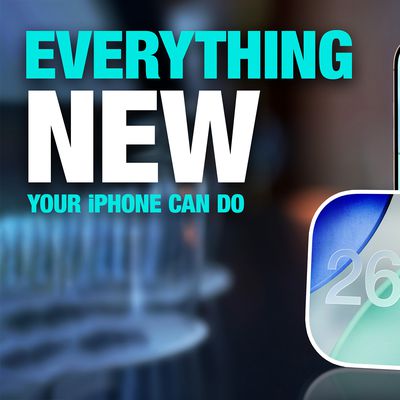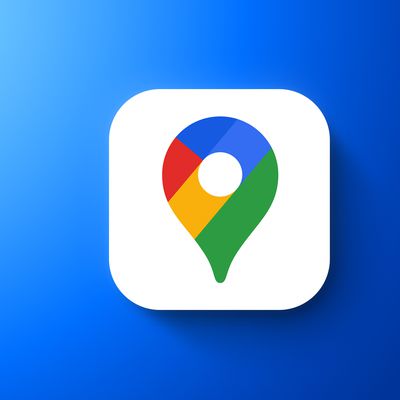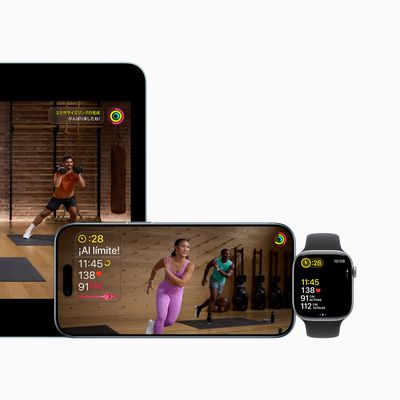Apple Vision Pro Can Now Be Controlled With Brain-Computer Interface
Apple's Vision Pro headset can now be controlled using only thoughts, thanks to integration with neurotechnology startup Synchron's brain-computer interface (BCI).

The company today announced that Apple Vision Pro has been successfully used by a patient through direct brain control facilitated by Synchron's brain-computer interface technology. Mark, a 64-year-old man suffering from amyotrophic lateral sclerosis (ALS), demonstrated the integration.
With this technology, Mark controlled the cursor on the Vision Pro to play Solitaire, watch Apple TV, and send text messages without using his hands, which he can no longer move due to his condition. The Vision Pro's reliance on hand gestures would otherwise pose a barrier for users like Mark who have lost upper limb functionality.
Mark has been practicing different skills and functions with his BCI twice a week since his implantation in August 2023. He noted that using the BCI to control the Vision Pro is similar to using it for his iPhone, iPad, and computer. Apple's suite of accessibility features across its platforms has been recognized for its excellence, which is why Synchron initially focused on integrating its BCI with Apple devices.
Synchron's brain-computer interface allows individuals with severe physical limitations to control digital devices with their thoughts. The BCI is implanted in the blood vessel on the surface of the motor cortex via a minimally invasive endovascular procedure. The device detects motor intent from the brain and wirelessly transmits these signals to external devices, enabling hands-free control. Tom Oxley, CEO and Founder of Synchron, said:
BCI is a platform to re-connect people with injury or disease back to the fast-moving consumer technology landscape. Vision Pro is a powerful system, but it relies on the use of hand gestures to exert control over the UI. We are sending control signals directly from the brain to replace the need for hand gestures. We are moving towards a new Bluetooth standard for Human Computer Interactions that do not require touch or speech. This is a critical unmet need for millions of people with paralysis.
Synchron is preparing for larger-scale clinical studies to expand the reach of its BCI technology. It has implanted its BCI in six patients in the United States and four in Australia. The company continues to seek approval from the U.S. Food and Drug Administration to commercialize its technology.
Popular Stories
Apple has ordered 22 million OLED panels from Samsung Display for the first foldable iPhone, signaling a significantly larger production target than the display industry had previously anticipated, ET News reports.
In the now-seemingly deleted report, ET News claimed that Samsung plans to mass-produce 11 million inward-folding OLED displays for Apple next year, as well as 11 million...
Apple is about to release iOS 26.2, the second major point update for iPhones since iOS 26 was rolled out in September, and there are at least 15 notable changes and improvements worth checking out. We've rounded them up below.
Apple is expected to roll out iOS 26.2 to compatible devices sometime between December 8 and December 16. When the update drops, you can check Apple's servers for the ...
Apple is actively testing under-screen Face ID for next year's iPhone 18 Pro models using a special "spliced micro-transparent glass" window built into the display, claims a Chinese leaker.
According to "Smart Pikachu," a Weibo account that has previously shared accurate supply-chain details on Chinese Android hardware, Apple is testing the special glass as a way to let the TrueDepth...
Apple today seeded the second release candidate version of iOS 26.2 to developers and public beta testers, with the software coming one week after Apple seeded the first RC. The release candidate represents the final version iOS 26.2 that will be provided to the public if no further bugs are found.
Registered developers and public beta testers can download the betas from the Settings app on...
Google Maps on iOS quietly gained a new feature recently that automatically recognizes where you've parked your vehicle and saves the location for you.
Announced on LinkedIn by Rio Akasaka, Google Maps' senior product manager, the new feature auto-detects your parked location even if you don't use the parking pin function, saves it for up to 48 hours, and then automatically removes it once...
Apple's chipmaking chief Johny Srouji has reportedly indicated that he plans to continue working for the company for the foreseeable future.
"I love my team, and I love my job at Apple, and I don't plan on leaving anytime soon," said Srouji, in a memo obtained by Bloomberg's Mark Gurman.
Here is Srouji's full memo, as shared by Bloomberg:I know you've been reading all kind of rumors and...
Apple's iPhone development roadmap runs several years into the future and the company is continually working with suppliers on several successive iPhone models at the same time, which is why we often get rumored features months ahead of launch. The iPhone 18 series is no different, and we already have a good idea of what to expect for the iPhone 18 Pro and iPhone 18 Pro Max.
One thing worth...
Apple and Google are teaming up to make it easier for users to switch between iPhone and Android smartphones, according to 9to5Google. There is a new Android Canary build available today that simplifies data transfer between two smartphones, and Apple is going to implement the functionality in an upcoming iOS 26 beta.
Apple already has a Move to iOS app for transferring data from an Android...
Apple today announced that Fitness+ is expanding to 28 new markets on December 15 in the service's largest international rollout since launch, accompanied by new language dubbing and a K-Pop music genre.
Apple Fitness+ will become available in Chile, Hong Kong, India, the Netherlands, Singapore, Taiwan, and additional regions on December 15, with Japan scheduled to follow early next year....
Apple's senior vice president of hardware technologies Johny Srouji could be the next leading executive to leave the company amid an alarming exodus of leading employees, Bloomberg's Mark Gurman reports.
Srouji apparently recently told CEO Tim Cook that he is "seriously considering leaving" in the near future. He intends to join another company if he departs. Srouji leads Apple's chip design ...
























